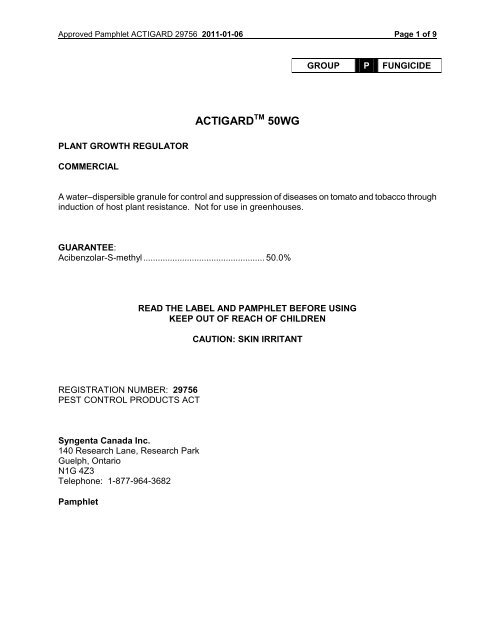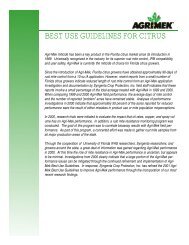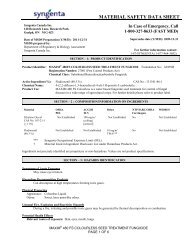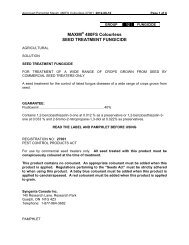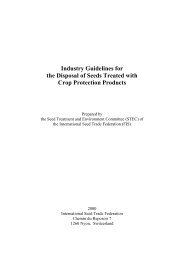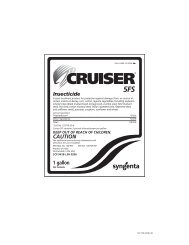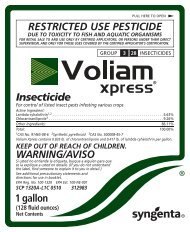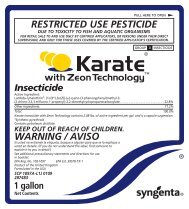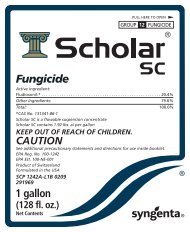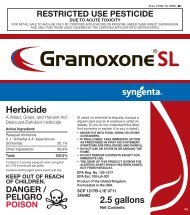QUADRIS - Syngenta Crop Protection
QUADRIS - Syngenta Crop Protection
QUADRIS - Syngenta Crop Protection
You also want an ePaper? Increase the reach of your titles
YUMPU automatically turns print PDFs into web optimized ePapers that Google loves.
Approved Pamphlet ACTIGARD 29756 2011-01-06 Page 1 of 9<br />
PLANT GROWTH REGULATOR<br />
COMMERCIAL<br />
ACTIGARD TM 50WG<br />
GROUP P FUNGICIDE<br />
A water–dispersible granule for control and suppression of diseases on tomato and tobacco through<br />
induction of host plant resistance. Not for use in greenhouses.<br />
GUARANTEE:<br />
Acibenzolar-S-methyl .................................................. 50.0%<br />
REGISTRATION NUMBER: 29756<br />
PEST CONTROL PRODUCTS ACT<br />
<strong>Syngenta</strong> Canada Inc.<br />
140 Research Lane, Research Park<br />
Guelph, Ontario<br />
N1G 4Z3<br />
Telephone: 1-877-964-3682<br />
Pamphlet<br />
READ THE LABEL AND PAMPHLET BEFORE USING<br />
KEEP OUT OF REACH OF CHILDREN<br />
CAUTION: SKIN IRRITANT
Approved Pamphlet ACTIGARD 29756 2011-01-06 Page 2 of 9<br />
NOTICE TO USER<br />
This pest control product is to be used only in accordance with the directions on the label. It is an<br />
offence under the Pest Control Products Act to use this product in a way that is inconsistent with the<br />
directions on the label. The user assumes the risk to persons or property that arises from any such<br />
use of this product.<br />
FIRST AID<br />
IN CASE OF POISONING, call a physician or poison control centre IMMEDIATELY. Take container,<br />
label or product name and Pest Control Product Registration Number with you when seeking<br />
medical attention.<br />
IF SWALLOWED, call a poison control centre or doctor IMMEDIATELY for treatment advice. Have<br />
person sip a glass of water if able to swallow. Do not induce vomiting unless told to do so by a<br />
poison control centre or doctor. Do not give anything by mouth to an unconscious person.<br />
IF ON SKIN/CLOTHING, take off contaminated clothing. Rinse skin IMMEDIATELY with plenty of<br />
water for 15-20 minutes. Call a poison control centre or doctor for treatment advice.<br />
IF IN EYES, hold eye open and rinse slowly and gently with water for 15-20 minutes. Remove<br />
contact lenses, if present, after the first 5 minutes, then continue rinsing eye. Call a poison control<br />
centre or doctor for treatment advice.<br />
IF INHALED, move person to fresh air. If person is not breathing, call 911 or an ambulance, then<br />
give artificial respiration, preferably by mouth-to-mouth, if possible. Call a poison control centre or<br />
doctor for further treatment advice.<br />
TOXICOLOGICAL INFORMATION<br />
There is no specific antidote known. Treat symptomatically.<br />
PRECAUTIONS<br />
KEEP OUT OF REACH OF CHILDREN. Hazards to Humans and Domestic Animals.<br />
May irritate the skin. Avoid contact with skin. Wash hands before eating, drinking, chewing gum,<br />
using tobacco or using the toilet. Wash thoroughly with soap and water after handling. Remove<br />
clothing immediately if pesticide gets inside. Then wash thoroughly and put on clean clothing.<br />
Wear chemical-resistant gloves made of any waterproof material, goggles, long-sleeve shirt, long<br />
pants, and shoes/boots with socks when mixing and loading product or during equipment clean-up<br />
and repair. During application, wear a long-sleeve shirt, long pants and shoes/boots with socks.<br />
DO NOT apply by air.<br />
Do not treat more than 100 ha per day.
Approved Pamphlet ACTIGARD 29756 2011-01-06 Page 3 of 9<br />
Not for use in greenhouses.<br />
If this pest control product is to be used on a commodity that may be exported to the U.S. and you<br />
require information on acceptable residue levels in the U.S., visit <strong>Crop</strong>Life Canada’s website at<br />
www.croplife.ca.<br />
ENVIRONMENTAL HAZARDS<br />
TOXIC to aquatic organisms.<br />
To reduce runoff from treated areas into aquatic habitats avoid application to areas with a moderate<br />
to steep slope, compacted soil, or clay.<br />
Avoid application when heavy rain is forecast.<br />
Contamination of aquatic areas as a result of runoff may be reduced by including a vegetative strip<br />
between the treated area and the edge of the water body.<br />
PHYSICAL OR CHEMICAL HAZARDS<br />
Do not use or store near heat or open flame.<br />
Do not enter or allow worker entry into treated areas during the restricted-entry interval (REI) of 12<br />
hours for tomatoes and 8 days for tobacco.<br />
STORAGE<br />
Store in a cool, dry place. To prevent contamination, store this product away from food or feed.<br />
DISPOSAL OF UNUSED, UNWANTED PRODUCT<br />
For information on disposal of unused, unwanted product, contact the manufacturer or the provincial<br />
regulatory agency. Contact the manufacturer and the provincial regulatory agency in case of a spill,<br />
and for clean-up of spills.<br />
CONTAINER DISPOSAL:<br />
For recyclable containers:<br />
Do not reuse this container for any purpose. This is a recyclable container, and is to be disposed of<br />
at a container collection site. Contact your local distributor/dealer or municipality for the location of<br />
the nearest collection site. Before taking the container to the collection site:<br />
1. Triple- or pressure-rinse the empty container. Add the rinsings to the spray mixture in the<br />
tank.<br />
2. Make the empty, rinsed container unsuitable for further use.<br />
If there is no container collection site in your area, dispose of the container in accordance with
Approved Pamphlet ACTIGARD 29756 2011-01-06 Page 4 of 9<br />
provincial requirements.<br />
IN CASE OF EMERGENCY INVOLVING A MAJOR SPILL, FIRE OR POISONING,<br />
CALL 1-800-327-8633 (FASTMED)<br />
PRODUCT INFORMATION<br />
ACTIGARD 50WG is a selective, non-pesticidal systemic compound used for the suppression<br />
bacterial spot and bacterial speck of tomatoes and the control of blue mold of tobacco. ACTIGARD<br />
50WG is an inducer of host plant resistance. ACTIGARD 50WG exhibits a unique mode of action<br />
which mimics the natural systemic activated resistance (SAR) response found in most plant species.<br />
ACTIGARD 50WG has no direct activity against target pathogens.<br />
A plant back interval of 30 days is required for all crops other than those listed on the ACTIGARD<br />
50WG label.<br />
FAILURE TO FOLLOW DIRECTIONS AND PRECAUTIONS ON THIS LABEL MAY RESULT IN<br />
CROP INJURY, POOR DISEASE CONTROL, AND/OR ILLEGAL RESIDUES.<br />
DIRECTIONS FOR USE<br />
As this product is not registered for the control of pests in aquatic systems, DO NOT use to control<br />
aquatic pests.<br />
DO NOT contaminate irrigation or drinking water supplies or aquatic habitats by cleaning of<br />
equipment or disposal of wastes.<br />
For best performance, always follow these directions:<br />
ACTIGARD 50WG should be applied to plant foliage preventively, before disease is observed in the<br />
field.<br />
ACTIGARD 50WG moves systemically within the plant; however uniform spray coverage is essential<br />
for best performance. Apply ACTIGARD 50WG by ground application in sufficient water to ensure<br />
uniform coverage. See instructions with each crop for specific recommendations.<br />
An ACTIGARD 50WG application mimics the SAR response in plants.<br />
Field sprayer application: DO NOT apply during periods of dead calm. Avoid application of this<br />
product when winds are gusty. DO NOT apply with spray droplets smaller than the American Society<br />
of Agricultural Engineers (ASAE) medium classification. Boom height must be 60 cm or less above<br />
the crop or ground.<br />
DO NOT apply by air.<br />
Follow the more stringent label precautions in cases where the operator precautions exceed the<br />
generic label recommendations on the existing ground boom label.
Approved Pamphlet ACTIGARD 29756 2011-01-06 Page 5 of 9<br />
All personnel on the job site must wash hands and face thoroughly before eating and drinking.<br />
Protective clothing and vehicle cabs must be decontaminated regularly.<br />
Product Specific Precautions<br />
Read and understand the entire label before opening this product. If you have questions, call the<br />
manufacturer or obtain technical advice from the distributor or your provincial agricultural<br />
representative. Application of this specific product must meet and/or conform to the following:<br />
Volume: Apply the recommended rate in a minimum spray volume of 100 litres per hectare.<br />
Mixing Procedures<br />
Prepare no more spray mixture than is needed for the immediate spray operation. Thoroughly clean<br />
spray equipment before using this product to prevent possible crop injury, mixing or nozzle clogging<br />
problems from spray tank contamination. Vigorous agitation is necessary for proper dispersal of the<br />
product. Maintain maximum agitation throughout the spraying operation. Do not let the spray<br />
mixture stand overnight in the spray tank. Flush the spray equipment thoroughly following each use<br />
and apply the rinsate to a previously treated area.<br />
1) Add 1/2 of the required amount of water to the mix tank.<br />
2) With the agitator running, add the ACTIGARD 50WG to the tank.<br />
3) Continue agitation while adding the remainder of the water. Begin application of the solution<br />
after the ACTIGARD 50WG has completely dispersed into the mix water.<br />
4) Maintain agitation until all of the mixture has been applied.<br />
Do not apply this product through any type of irrigation system.
Approved Pamphlet ACTIGARD 29756 2011-01-06 Page 6 of 9<br />
FRUITING VEGETABLES<br />
<strong>Crop</strong> Tomato<br />
Target Disease Bacterial Spot (Xanthomonas campestris pv. vesicatoria)<br />
Bacterial Speck (Pseudomonas syringae pv. tomato)<br />
Use Rate 25 g product/ha<br />
Application Interval 7 days<br />
Remarks Begin applications within one week of transplanting or emergence.<br />
Make up to 8 weekly sequential applications.<br />
Apply in a water volume between 280 – 655 L/ha. Begin season with low water<br />
volumes. As plant canopy increases, increase the water volume for deliver<br />
accordingly.<br />
ACTIGARD 50WG should be applied to healthy, actively growing plants. Do not apply<br />
ACTIGARD 50WG to plants that are stressed due to drought, excessive moisture,<br />
cold weather, or herbicide injury.<br />
Do not apply within 14 days of harvest.<br />
Do not apply more than 8 times per crop season.<br />
Do not apply on less than a 7-day interval.<br />
Do not apply more than 200 g/ha of ACTIGARD 50WG per season.<br />
Precaution: Under certain conditions, this product, when used on tomatoes<br />
may lead to reductions in yield. <strong>Syngenta</strong> recommends that the user and/or<br />
grower test this product in order to determine its suitability for its intended use<br />
in tomatoes. <strong>Syngenta</strong> makes this product available to the user and/or grower<br />
solely to the extent that the benefit and utility, in the sole opinion of the user<br />
and/or grower, outweigh the extent of potential reductions in yield of tomatoes<br />
following use of ACTIGARD 50WG. The decision to use or not use ACTIGARD<br />
50WG in tomatoes must be made by each individual user and/or grower on the<br />
basis of possible reductions in yield, the severity of disease incidence, the cost<br />
of alternate disease control options, if any, and other factors.
Approved Pamphlet ACTIGARD 29756 2011-01-06 Page 7 of 9<br />
TOBACCO<br />
<strong>Crop</strong> Tobacco (Burley and Binder)<br />
Target Disease Blue Mold (Peronospora tabacina)<br />
Use Rate 35 g/ha<br />
Application Interval 10 days<br />
Remarks Apply on a preventive schedule when blue mold threatens.<br />
Begin applications when plants are an average of 45 centimetres (18 inches) tall.<br />
Another registered blue mold product should be used prior to 45 centimetres (18<br />
inches) for early season control and after the final application if conditions are<br />
conducive for disease.<br />
Make up to 3 applications on a 10-day schedule.<br />
Applications of ACTIGARD 50WG may result in leaf yellowing. This cosmetic<br />
yellowing normally disappears after the final application.<br />
ACTIGARD 50WG should be applied to healthy, actively growing plants. Do not apply<br />
ACTIGARD 50WG to plants that are stressed due to drought, excessive moisture,<br />
cold weather, or herbicide injury.<br />
Do not apply ACTIGARD 50WG to tobacco in plant beds or in greenhouses/plant<br />
houses.<br />
Do not apply ACTIGARD 50WG with foliar fertilizers and crop oils.<br />
Avoid spray overlap because injury may result.<br />
Do not apply within 21 days of harvest.<br />
Do not apply more than 105 g of ACTIGARD 50WG per hectare per season.
Approved Pamphlet ACTIGARD 29756 2011-01-06 Page 8 of 9<br />
<strong>Crop</strong> Tobacco (Flue-cured and Dark)<br />
Target Disease Blue Mold (Peronospora tabacina)<br />
Use Rate 35 g/ha<br />
Application Interval 10 days<br />
Remarks Apply on a preventive schedule when blue mold threatens.<br />
Begin applications when plants are an average of 30 centimetres (12 inches) tall.<br />
Another registered blue mold product should be used prior to 30 centimetres (12<br />
inches) for early season control and after the final application if conditions are<br />
conducive for disease.<br />
Make up to 3 applications on a 10-day schedule.<br />
Applications of ACTIGARD 50WG may result in leaf yellowing. This cosmetic<br />
yellowing normally disappears after the final application.<br />
ACTIGARD 50WG should be applied to healthy, actively growing plants. Do not apply<br />
ACTIGARD 50WG to plants that are stressed due to drought, excessive moisture,<br />
cold weather, or herbicide injury.<br />
Do not apply ACTIGARD 50WG to tobacco in plant beds or in greenhouses/plant<br />
houses.<br />
Do not apply ACTIGARD 50WG with foliar fertilizers and crop oils.<br />
Avoid spray overlap because injury may result.<br />
Do not apply within 21 days of harvest.<br />
Do not apply more than 105 g of ACTIGARD 50WG per hectare per season.<br />
RESISTANCE MANAGEMENT RECOMMENDATIONS<br />
For resistance management, please note that ACTIGARD 50WG contains a Group P fungicide.<br />
ACTIGARD 50WG exhibits a mode of action unique from currently available fungicides and<br />
bactericides. Since ACTIGARD 50WG has no direct activity on plant pathogens, the likelihood that<br />
resistance (insensitivity) will develop in the pathogens is low. However, plant pathogens are known<br />
to develop tolerance to host plant resistance and to products used repeatedly for control. Because<br />
insensitivity development cannot be fully predicted, the use of this product should conform to<br />
sensitivity management strategies established for the crop and use area. Such strategies may<br />
include rotating and/or tank mixing with products with different modes of action as well as the use of<br />
good cultural practices. Consult your local pest control advisor or extension office for details. If<br />
insensitivity to this product develops in your area, this product or other products with a similar mode<br />
of action may not provide adequate control. If you experience difficulty with control, and insensitivity<br />
is a likely cause, consult your local <strong>Syngenta</strong> <strong>Crop</strong> <strong>Protection</strong> representative, local agricultural<br />
extension office, or pest control advisor for the best alternative method of control. <strong>Syngenta</strong><br />
encourages responsible product stewardship to ensure effective long-term disease control.<br />
To delay fungicide resistance:<br />
Where possible, rotate the use of ACTIGARD 50WG or other Group P fungicides with different<br />
groups that control the same pests in a field.
Approved Pamphlet ACTIGARD 29756 2011-01-06 Page 9 of 9<br />
Use tank mixtures with fungicides from a different group when such use is permitted.<br />
Fungicide use should be based on an IPM program that includes scouting, record keeping, and<br />
considers cultural, biological and other chemical control practices.<br />
Monitor treated pest populations for resistance development.<br />
Contact your local extension specialist or certified crop advisors for any additional pesticide<br />
resistance-management and/or IPM recommendations for the specific site and pest problems in<br />
your area.<br />
For further information or to report suspected resistance, contact company representatives at<br />
1-87-SYNGENTA (1-877-964-3682) or at www.syngenta.ca.<br />
ACTIGARD TM is a trademark of a <strong>Syngenta</strong> Group Company


